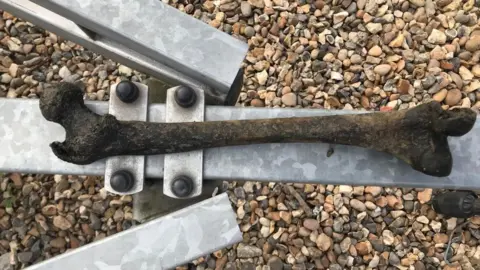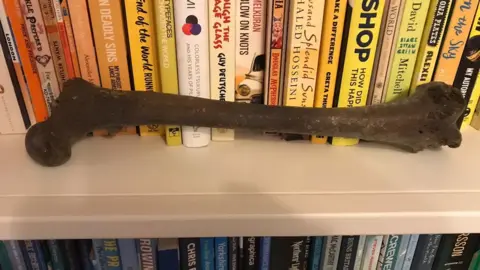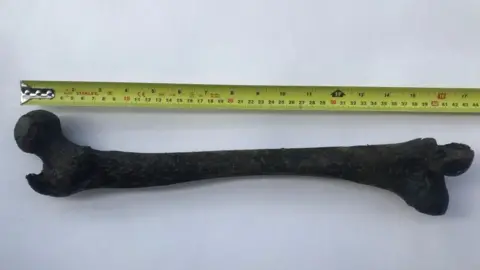The 5,000-year-old human bone found in the River Thames
 Simon Hunt
Simon HuntAs he went out for a row one morning on the River Thames in London, graphic designer Simon Hunt came across a rather unexpected find.
Lying on the pebbles and rocks of the riverbed at low tide was a human femur, or upper leg bone.
Carbon dating has since indicated it to be more than 5,000 years old, but having recognised it to be from a person he immediately began to fear the worst.
"It looked very old, but part of me was thinking what if it isn't?" Mr Hunt said.
"I have no idea what a bone would look like if it had only been in the water for two years, so what if it was something more sinister?"
 Simon Hunt
Simon HuntIn order to keep it safe he plucked the bone from where it lay and took it with him as he rowed up and down the river.
Once done, Mr Hunt placed the femur in a clear plastic bag and took it home to show his wife, carrying it in full view of passers-by. Yet nobody batted an eyelid.
He then called the police, who asked him to show them where he had found the thighbone so they could investigate. However, by the time officers had arrived, the tide had come in and the spot was deep underwater.
The police decided to send the bone for lab testing. Mr Hunt had to wait several months before investigators called him and asked him to bring a bag to the police station to collect it.
"They told me it was old, and asked me to guess when it was from.
"My own frame of reference for old things that are tangible is sort of medieval, but I was way off," Mr Hunt said.
 Getty Images
Getty ImagesIt had in fact come from someone who lived in the late British Neolithic period - the end of the Stone Age. Experts had been able to date it to between 3516 and 3365 BC.
Neolithic Britain saw the arrival of farming culture, as migrants brought techniques and tools from continental Europe.
An archaeologist estimated the height of the person it belonged to as about 5ft 7in (170cm) tall, but it's not been possible to tell if they were male or female.
The age of the bone means it's older than both Stonehenge in the UK and Egypt's Pyramids of Giza.
"People have said to me they think it's weird that I found it in London, but we have to remember there was no London then," Mr Hunt said.
"I think it must've been in mud or something, as it's so well-preserved, and then it was disturbed and found its way to me in the river."
 Simon Hunt
Simon HuntThe Museum of London, which Mr Hunt hopes will become the eventual home for the bone, has a fragment of a Neolithic skull which is dated between 3645 and 3600 BC.
According to the museum, the skull is one of the oldest things retrieved from the River Thames. Mr Hunt hopes the bone will one day sit alongside it.
In the meantime, the femur remains with him.
"I hadn't really thought about where I'd keep it, but it will have to be somewhere where the cat can't have a nibble," he explained.
"I want to be respectful because this was a person.
"This bone was part of someone's leg, who was walking around here more than 5,000 years ago."
 Getty Images
Getty ImagesThe Thames has proven to be a veritable treasure trove of historic artefacts over the years. Mudlarkers - people who search for items of value lying on the banks of the river - have found many of the items in the Museum of London's collection.
In the capital, a licence is required from the Port of London Authority to take part in this activity and it is illegal to search for or remove artefacts of any kind from the foreshore without one.
But on this occasion, Mr Hunt was carrying out his civic duty, and so far nobody has been upset about him retrieving the bone.
Technicalities aside, it was merely a lucky find that made one of his morning rows a great deal more interesting.

Follow BBC London on Facebook, Twitter and Instagram. Send your story ideas to [email protected]
